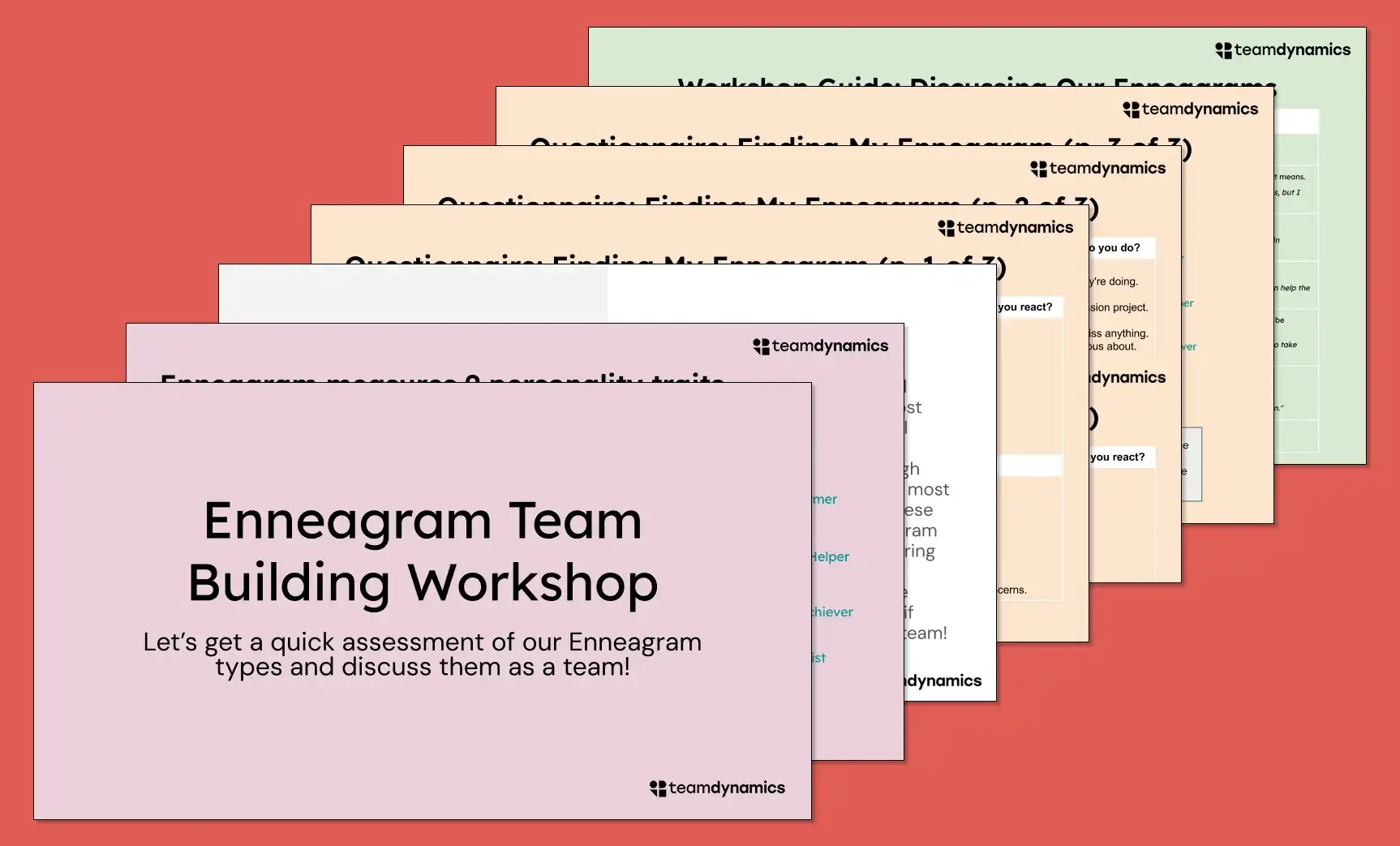Wondering what makes your team members tick? Want to unlock the secrets of stellar teamwork? The answer could lie in the Enneagram, an ancient personality system that's gaining modern traction. This blog post will dive deep into the Enneagram's impact on team dynamics and offer a free downloadable Discussion Guide to help you get started. Read on to supercharge your team!
Looking for a personality test to help your team improve its performance? Try TeamDynamics!
What You'll Learn:
- What is the Enneagram?
- How it can supercharge teamwork
- How to lead a team discussion on Enneagram types
What is the Enneagram?
The Enneagram is a personality system that sorts people into nine core types. It goes beyond surface traits to uncover the motivations behind your actions.
The Enneagram is like a big pie chart with nine slices. Each slice is a different personality type. The nine types are:
- The Reformer: Wants to be right and good.
- The Helper: Lives to help others.
- The Achiever: Wants to win and look good doing it.
- The Individualist: Craves being special and unique.
- The Investigator: Loves to think and learn.
- The Loyalist: Values trust and security.
- The Enthusiast: Seeks fun and new experiences.
- The Challenger: Loves control and challenges.
- The Peacemaker: Wants peace and avoids conflict.

But wait, there's more! Lines connect these nine points. They show how your personality changes when you're stressed or relaxed.
Also, each type has a "wing," which means it leans a bit towards one of its neighbors. For example, a "1 with a 2 wing" is mostly a Perfectionist but has some Helper traits too.
The Enneagram's roots are a bit mysterious. Some say it goes back to ancient spiritual traditions, while others point to more recent developments in psychology. In the 20th century, it got a boost from folks like George Gurdjieff and later, Oscar Ichazo. Today, it's super popular, especially for self-help and team building.
Looking for something other than the Enneagram? Here are the top 5 alternatives to Enneagram!
Practical Uses
- Self-Awareness: Helps you understand why you do what you do.
- Relationships: Makes it easier to get along with people by understanding their quirks.
- Team Building: Helps teammates understand how to work well together.
- Personal Growth: Points out what you're good at and what you could work on.
Strengths
- Depth: Goes beyond surface-level traits to dig into motivations.
- Flexibility: Allows for "wings" and other nuances that make you unique.
- Actionable Insights: Offers concrete steps for self-improvement.
- Community: There's a big, friendly community of Enneagram fans to learn from.
Limitations
- Not Science-Backed: Unlike some other personality tests, it's not super scientific.
- Focused on Individuals (not teams): Unlike TeamDynamics, Enneagram isn't made specifically for teams.
- Complexity: Can be hard to grasp all the layers and nuances at first.
- Stereotyping: Easy to pigeonhole people based on their type.
- Cost: Some Enneagram resources and courses can be pretty pricey (but this one is free!).
{{inline-cta}}
Why the Enneagram Matters for Teams
Teams can be like puzzles, and the Enneagram is your cheat sheet to solving them. Here’s how it can help:
Looking for a personality test that is specifically made to help modern teams improve their teamwork? Try TeamDynamics!
Better Communication
Knowing each other's Enneagram types can make conversations flow smoother. No more awkward misunderstandings!
Improved Collaboration
When you understand the strengths of each Enneagram type, assigning tasks becomes a breeze. Everyone gets to shine!
Greater Empathy
The Enneagram helps you understand why people act the way they do. This can dial down conflicts and boost team morale.
An Enneagram Team Discussion Guide
Enough with the theory—let's get practical. We've prepared a team discussion guide that you can download for free. It’s designed to help teams discuss their Enneagram types in a constructive way.
How Does It Work?
- Introduction: Brief your team on the Enneagram and why it matters.
- Share and Tell: Each member shares their Enneagram type and a bit about what it means.
- Common Ground: Discuss common strengths across different types on your team.
- The Mix & Match: Talk about how different types can complement each other at work.
- Growth Zones: Openly discuss the challenges each type might face and how the team can help.
- Action Steps: Conclude by committing to concrete steps to improve teamwork.
Why It's A Must-Try
- Deep Understanding: Get to know your teammates on a whole new level.
- Stronger Bonds: The more you understand each other, the better you get along. It’s that simple.
- Real Solutions: End the discussion with actionable steps for everyone to take.
How to Dive In
Eager to get started? Follow these simple steps:
- Download Our Free Discussion Guide: It includes everything you need for a fruitful discussion on your team's Enneagram types.
- Book a Team Meeting: Make sure everyone can attend and is prepared to engage.
- Lead the Discussion: Use the guide to facilitate an enriching conversation.
- Take Action: Implement the insights gained into everyday team interactions.
Conclusion
The Enneagram isn’t just another fad—it’s a tried-and-true system for understanding human behavior. With our free downloadable discussion guide, you’re all set to dive into the fascinating world of Enneagram types and team dynamics.
So don’t wait. Download the guide, call a team meeting, and get ready to unlock new levels of teamwork and understanding.




.png)







































